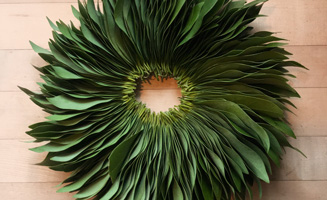

Contributor
- Topics: Archive

Humans crave green and hunger for nature. As life becomes increasing busy, crowded, urban, and wired, satisfying that hunger is an important aspect of health and happiness. Author Richard Louv calls it getting our dose of vitamin N.
Last week Pantone, masters of color, announced their Color of the Year pick for 2017: Greenery (15-0343). So it’s official. Now artists, designers, and industry experts in fashion and home decor know what gardeners have grasped since the first seedling—green revives, restores, and rejuvenates.
A recent crop of titles by West Coast authors read like fresh breezes through an open window to refresh this sometimes stuffy, indoor time of the year. Filled with creative projects and exercises that cultivate an awareness of the seasons, growth, and fruitful ripening, these books are inspirational, thoughtful, and grounded in nature; a welcome dose of vitamin N for gardeners and non-gardeners alike.
The world needs more gardeners. I’m intrigued by the notion of gardeners without a garden. Indoor garden projects like the ones included in these books may bridge that gap for those without access to an outdoor space. And for those of us lucky enough to have a plot to tend, like the dirt we tramp through the house, these projects offer another way for the garden to follow us indoors.
Reading their essays, head notes, and personal narratives, I found these authors to have a huge heart for nature and the many fruits of the landscape. Let me be clear—these are not decorating books. Instead, each project is rooted in the natural landscape, even the wilderness.
 Plant Craft: 30 projects that add natural style to your home, Caitlin Atkinson, Timber Press, 2016.
Plant Craft: 30 projects that add natural style to your home, Caitlin Atkinson, Timber Press, 2016.
Solid garden information and a talented stylist’s keen eye for beauty grounds every effort in this beautiful book. Most of the projects incorporate living plants and, naturally, are subject to the same light and moisture requirements of outdoor gardens. From simple gestures to more complex undertakings, Caitlin’s emphasis on natural and foraged materials —rocks, moss, branches, and blossoms—insure an authentic garden experience. During the past several weeks I’ve crafted several uncomplicated but pleasingly sophisticated (and gloriously fragrant) wreaths using bay leaves harvested from my back garden (see lead photo). And once the crush of the holidays has passed, I’ve got my sites on having a go at anthotype photograms, botanical prints crafted from natural plant-based emulsions.
 Natural Color: Vibrant plant dye projects for your home and wardrobe, Sasha Duerr, photography by Aya Brackett, Watson-Guptill Publications,
Natural Color: Vibrant plant dye projects for your home and wardrobe, Sasha Duerr, photography by Aya Brackett, Watson-Guptill Publications,
Several years ago Oakland-based Sasha Duerr sparked my imagination when I heard her speak about harvesting local plants to discover colors that were unique to a location and a singular moment of the year. Harvesting late-summer blackberries meant more than pie that year and the resulting earthy-pink fabric I cooked up on my stovetop was stunning. It also lasted much longer than the pie and became an enduring marker of my favorite time of the year. Natural Color brings this celebration of nature’s seasonal palette to readers in a beautiful book that is equal parts inspiration and practical how to. Sasha leads readers through the calendar year and the landscape uncovering hidden colors in gardens, weed lots, woods, and even surprising hues to be found in fruit and vegetable scraps that she calls compost colors. Who knew avocado pits could yield a delicate shell pink?
 Foraged Flora: A Year of Gathering and Arranging Wild Plants and Flowers, Louesa Roebuck & Sarah Lonsdale, photography by Laurie Frankel, Ten Speed Press, 2016
Foraged Flora: A Year of Gathering and Arranging Wild Plants and Flowers, Louesa Roebuck & Sarah Lonsdale, photography by Laurie Frankel, Ten Speed Press, 2016
The remarkably beautiful Foraged Flora is at once a celebration of nature and a meditation on its fleetingness. Essays and observations by the authors accompany sumptuous photos of arrangements that range from the simple—a single exquisite stem of flowering magnolia in February—to the maximal visual opulence of an overhead bower of roses and vining clematis—replete with shattering blooms and a carpet of petals—marking the month of August. Weeding roadside fennel and humble nasturtiums from the vegetable plot also star in a floral practice that embraces all of nature’s abundance.
Most gardeners I know intuitively gather posies as we tend and tidy our plants. Brought indoors and plunked in a mason jar these simple bouquets take over windowsills and tabletops, basically any flat surface that will hold them, in a celebration of the season (sweet peas!) and a reminder that we’d rather be gardening. Now, thanks to the efforts of another West Coast garden visionary, anyone can savor seasonal, local garden flowers. Debra Prinzing created SlowFlowers.com, an online directory to florists, shops, and studios who design with American-grown flowers, in 2013. Since that time, Slow Flowers has becomes a community—a gift to consumers looking to source regional blooms and a boon to small businesses and flower farmers looking to share their good work in a competitive marketplace.
Gardens—they’re not just for gardeners these days.
Share:
Social Media
Garden Futurist Podcast
Most Popular
Videos
Topics
Related Posts

Low Maintenance Gardens – Better for Pollinators and People
Autumn 2022 “I come out every day. It’s therapy, my meditation.” Janet’s young garden transformed from overgrown, invasive plants to mostly natives. The dailiness of

Invasive Plants Are Still Being Sold: Preventing Noxious Weeds in Your Landscape
Autumn 2022 With so many beautiful ornamental plant species and cultivars throughout California and the Pacific Northwest, how do you decide which ones to include

Garden Design in Steppe with Transforming Landscapes with Garden Futurist Emmanuel Didier
Summer 2022 Listen to full Garden Futurist: Episode XVII podcast here. Emmanuel Didier, Principal and Creative Director at Didier Design Studio is a leading figure

Seslerias: Versatile Groundcover Meadow Grasses
Summer 2022 Without question, the most beautiful and versatile of all the groundcover meadow grasses are the moor grasses (Sesleria). Moor grasses tick off all









Responses